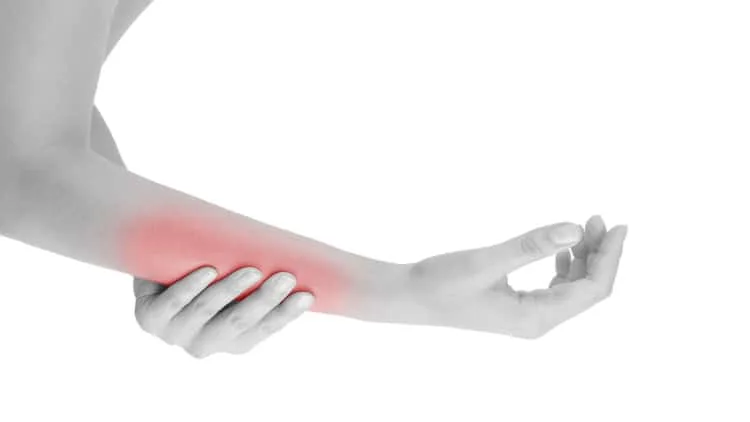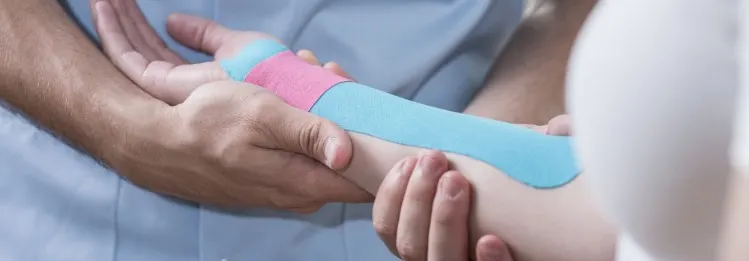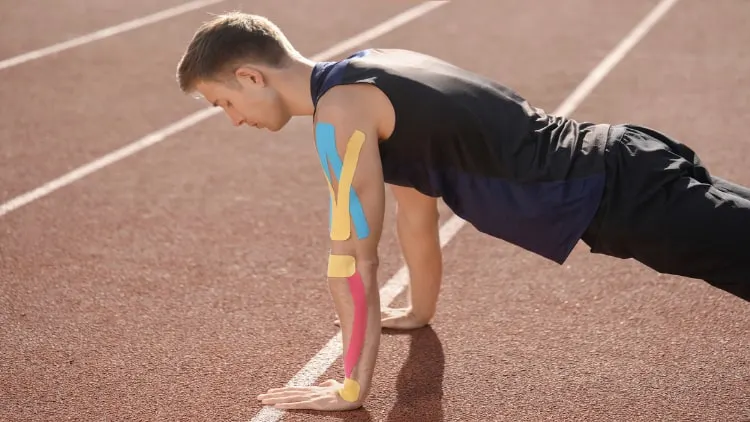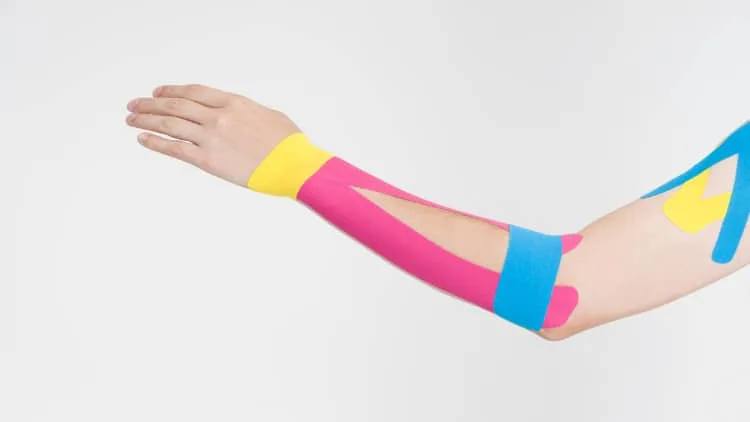The muscles of the forearm are complex and numerous. And due to their involvement in various sports, exercises, and daily activities, they’re more vulnerable to injury than other body parts.
This is where forearm strapping or kinesiology tape can come in handy. So let’s take a look at the benefits and then see what types of forearm strapping are available (and which is the best).
What is forearm strapping?
Forearm strapping describes a wrap that you place around your forearm to speed up recovery from training or injury via compression. In practice, this can be a simple medical bandage, but most often, the strapping comes in the form of kinesiology tape.
There are countless brands of this tape on the market, but most do the same thing. Obviously, the quality can differ from brand to brand, so I’ll share my recommended products a bit later on so that you don’t get ripped-off.
Related posts: forearm tendonitis brace│forearm wrap
Forearm strapping benefits
Forearm strapping isn’t for everyone, and it’s a good idea to talk to your doctor or physiotherapist to see if you can benefit from it. That said, as more research comes out in this area of study, the benefits of strapping up are becoming more apparent to coaches, athletes, and physios.
Faster injury recovery

Wearing forearm strapping alone won’t do much for injuries. However, when combined as part of a good Rest, Ice, Compression, Elevation protocol, it can help to speed up healing time.
This is because the compression offered by tape and strapping reduces swelling and promotes blood flow to damaged tendons, ligaments, and muscle tissue.
Combine this with resting your forearms, and you have an ideal environment for recovery. Depending on the condition, some physios get the same benefit from applying kinesiology tape to the forearm as they would from icing the same area due to its capacity to reduce swelling of the affected location.
The 4 Arm Strong can help as well if you have a “pumping” sensation in your lower arms. This is common with rowers, mountain bikers, and climbers.
Supports your muscles

We all have weak muscle groups. Perhaps we’re rehabbing from an injury or just have a problem area that’s lagging behind the rest of our body.
Well, traditionally, people would use a rather restrictive tape. And while this athletic tape can indeed support your muscles, it doesn’t allow for an unrestricted movement like forearm strapping, which is to say, kinesiology tape.
Better athletic performance

We’ve all seen that person covered in kinesiology tape. And that’s because many runners and gym-goers, for example, believe that the strapping can improve their performance by offering muscular support without restricting their movement.
This is why forearm strapping is particularly common in sports like rugby, rowing, and running, where the movement is very dynamic. With weight lifting, on the other hand, participants don’t frequently use forearm strapping because the exercises aren’t as dynamic. Therefore they don’t require the same freedom of movement.
Read more: forearm compression sleeve for tendonitis
Which forearm strapping is best?
First of all, you’ll need to choose between kinesiology tape and forearm bands, which typically go just above the elbow. While these small bands are widely available (as is kinesiology tape) and are easy to attach to your forearm, it’s a good idea to talk to your physio to see which they think is the best for your specific injury or sport.
Overall, kinesiology tape [1] is the most popular method of compression, but it’s also the most complex to apply if it’s your first time using it, especially because there’s no one-size-fits-all method for applying it to your forearms.
With a simple forearm strap or bandage, on the other hand, you can simply loop it over your lower arm and then fasten the velcro or buckle. The downside is that these devices can only be altered in terms of tightness, which you don’t want to over exaggerate.
With tape, on the other hand, you can apply it in various directions and at various stretches to get different benefits. So as I say, chat with your physio and see what they think is best.
The verdict on forearm strapping
Forearm strapping is common among people who play sports because it supports their muscles and even increases their strength levels without restricting their movement. [2]
It’s also commonly used for injury recovery because it nicely compresses the muscle, which can reduce swelling by promoting blood flow to damaged connective tissue.
And while there are helpful videos online from qualified physiotherapists, it can be tricky to apply the strapping without hands-on professional guidance. So if you’re interested in the long-term benefits of using forearm strapping, then it might be worth booking in with a physio for a session, even if it does cost you a bit of money.
References
- Kouhzad Mohammadi, H., Khademi Kalantari, K., Naeimi, S. S., Pouretezad, M., Shokri, E., Tafazoli, M., Dastjerdi, M., & Kardooni, L. (2014). Immediate and Delayed Effects of Forearm Kinesio Taping on Grip Strength. Iranian Red Crescent Medical Journal, 16(8). https://doi.org/10.5812/ircmj.19797
- Cha, H.-G., Kim, M.-K., & Shin, Y.-J. (2016). Immediate effects of forearm elastic and nonelastic taping on wrist flexor muscle and grip strength of normal adults. Journal of Physical Therapy Science, 28(10), 2769–2771. https://doi.org/10.1589/jpts.28.2769


